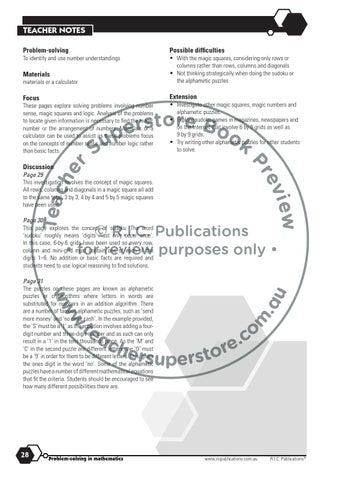TEACHER NOTES Problem-solving
Possible difficulties
To identify and use number understandings
materials or a calculator
• With the magic squares, considering only rows or columns rather than rows, columns and diagonals • Not thinking strategically when doing the sudoku or the alphametic puzzles
Focus
Extension
These pages explore solving problems involving number sense, magic squares and logic. Analysis of the problems to locate given information is necessary to find the magic number or the arrangement of numbers. Materials or a calculator can be used to assist as these problems focus on the concepts of number sense and number logic rather than basic facts.
• Investigate other magic squares, magic numbers and alphametic puzzles. • Explore sudoku games in magazines, newspapers and on the Internet that involve 6 by 6 grids as well as 9 by 9 grids. • Try writing other alphametic puzzles for other students to solve.
r o e t s Bo r e p ok u S
Discussion
Page 29 This investigation involves the concept of magic squares. All rows, columns and diagonals in a magic square all add to the same total. 3 by 3, 4 by 4 and 5 by 5 magic squares have been used. Page 30 This page explores the concept of sudoku. The word ‘sudoku’ roughly means ‘digits must only occur once’. In this case, 6-by-6 grids have been used so every row, column and mini-grid must contain one of each of the digits 1–6. No addition or basic facts are required and students need to use logical reasoning to find solutions.
ew i ev Pr
Teac he r
Materials
w ww
Page 31 The puzzles on these pages are known as alphametic puzzles or cryptorithms where letters in words are substituted for numbers in an addition algorithm. There are a number of famous alphametic puzzles, such as ‘send more money’ and ‘no more cash’. In the example provided, the ‘S’ must be a ‘1’ as the equation involves adding a fourdigit number and three-digit number and as such can only result in a ‘1’ in the tens thousands place. As the ‘M’ and ‘C’ in the second puzzle are different letters, the ‘O’ must be a ‘9’ in order for them to be different letters. This gives the ones digit in the word ‘no’. Some of the alphametic puzzles have a number of different mathematical equations that fit the criteria. Students should be encouraged to see how many different possibilities there are.
. te
28
m . u
© R. I . C.Publ i cat i ons •f orr evi ew pur posesonl y•
o c . che e r o t r s super
Problem-solving in mathematics
www.ricpublications.com.au
R.I.C. Publications®
